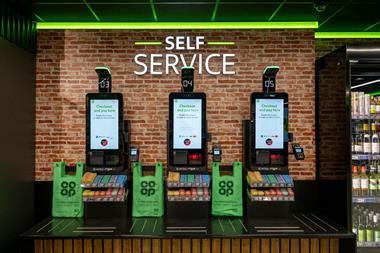Sainsbury’s strongly believes regular monitoring of its stores is crucial to ensure its customer experience isn’t a mystery
Once every two weeks, in every store in Sainsbury’s portfolio, you may find one particular customer paying close attention to what’s going on in the store. They might ask questions about a product, be hunting down out of stocks, or taking an interest in how long the queues are at the tills.
In other words, they’ll be acting in just the same way as any other customer in a Sainsbury’s might be. The only difference comes when they get home from their trip, sit down at their computer and fill in a questionnaire about their shopping experience that day, including rating the store and staff on a number of factors.
Sainsbury’s is committed to its mystery shopping programme, saying that great service helps to drive sales. So exactly how does this mystery shopping programme work, and why does Sainsbury’s think it provides such good value for money?
The programme has grown over 10 years, with Sainsbury’s working with one provider, ABa Quality Monitoring - which has 35 trained assessors working on the grocer’s behalf. It monitors stores, but also contact centres and ad-hoc projects, such as measuring the performance of Sainsbury’s Finance.
A worthwhile experience
Sainsbury’s colleague engagement director Jacki Connor, who was until recently the grocer’s customer service director, says: “It was low-key when it started and has developed as an iterative process. We look at what the customer wants from us from a service perspective.”
She explains that the main stores questionnaire rates each shop on aspects of the experience that every customer would notice when they visited: “The core for all stores is always about cleanliness, shopfloor service and checkouts. That can be measured in all stores.”
Sainsbury’s worked with ABa to create the questionnaire, much of which is common sense stuff, such as availability levels, having staff who can help you find products and short queues.
ABa Quality Monitoring account director Jill Spencer explains that the questions mystery shoppers might ask staff are everyday questions, so there is no reason for them to stand out or be treated any differently.
“If we can see an out-of-stock, we ask staff to go and look in the back, or look on the computer at the front of the store to find out when the product will be back in stock,” Spencer explains.
Additional questions have been added to the store questionnaire to assess newer parts of Sainsbury’s in-store proposition - such as clothing or electricals. However, it is kept to about two pages long, with no more than one bolt-on element to the core questions so the mystery shoppers are able to recall everything that happened and everything they looked out for once they leave the store.
For instance, measurement of the self-checkout experience is done as a bolt-on to the main questionnaire. “When we started to roll out self-checkout we wanted to stress-test it, and the mystery shoppers are really good at that,” says Connor. She explains that Sainsbury’s knew some customers were really nervous about using the self-checkouts and so it was helpful to have the mystery shoppers going in and checking what the experience of using them was like.
Sainsbury’s has extended the same mystery shopping discipline to other aspects of its proposition, as every touchpoint must attempt to give the same level of service, whether it is really Sainsbury’s staff that customers are dealing with or not. “Things like the contact centre - even when customers phone Sainsbury’s Bank - they think they are phoning someone in Sainsbury’s,” notes Connor.
The contact centre programme also covers Sainsbury’s own store support centre, to look at how well the central teams support their stores through the telephone service they provide.
For the store programme, members of staff from the training team at ABa Quality Monitoring go out with the mystery shoppers regularly to ensure that they are uniform in how they act in store. They use a guide for scoring, so that each is doing this in a similar manner meaning the statistics have relevance over time.
“Every day an assessor might do six to eight visits, and at night enter them into a database and award scores. Data processors then check the information and upload it to a Sainsbury’s website, normally within 72 hours of the visit,” Spencer explains.
Quality and quantity
The bespoke web reporting system ABa has created for Sainsbury’s allows the grocer’s staff to access both qualitative and quantitative information, enabling tracking and charting of customer service across different levels of the business.
There are two streams of reporting - one for head office and one for stores - that staff can access. Staff across the business receive bonuses based on the results of the mystery shopping programme. “I don’t see how you can bonus staff in branches unless you can measure like-for-like,” Spencer says, highlighting one of the benefits of using professional mystery shoppers rather than real customers - who would tend to give subjective views.
Connor agrees very strongly with this point. She says that store teams use the information that is collected a great deal, not least because they get bonuses on the results of the mystery shopping. “Everyone in the whole business is bonused on customer service. It is important for them to know when they are doing well and not doing so well. They get the reports every two weeks.”
Connor was involved with the programme when it stepped up from assessing stores one a month to once every fortnight and says that the frequency of visit make it business as usual for stores. “I launched the change to every other week, as before if a store had a bad result,the staff had to walk around with that for four weeks.”
Connor says that it can take a number of months to improve stores once something goes wrong. But she adds that even the best stores
can sometimes have blips and so it is helpful for morale that they are assessed again only two weeks later and have the chance to turn things around quickly.
Stores receive a congratulatory letter when they achieve a 100% score and feedback is given to individual staff members who are mentioned in the mystery shoppers’ reports.
Even though the assessments have been made slightly harder every year the pass rates have improved year on year. Changes to the survey are made each year to reflect what Sainsbury’s believes is most important to its customers. Connor also believes that the continual feedback that stores gets has been important to delivering this level of feedback.
She concludes: “If we could afford to do it every week we probably would.”


























No comments yet